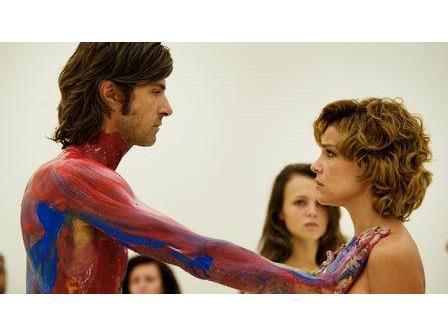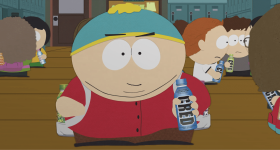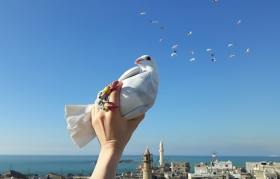Daniele Luchetti’s Those Happy Years is a superb, moving film; set in the 1970s, it captures the spirit of an era and the struggles of an artistic family. No clichéd moments are present throughout the film; on the contrary, some moments are so beautiful and unique they take the breath away. The film is also funny and warm, drenched in the passion of its protagonists and told from the perspective of a young Dario (Samuel Garofalo) who will one day grow into an artist like his father, Guido (Kim Rossi Stuart). The minutes and the hours of the film melt away like the concerns of another life.
The narrative follows Guido, an exceptionally talented sculptor, and his supportive but justifiably possessive wife Serena (Micaela Ramazzotti). Eschewing traditional forms of sculpture (as the narrator remarks, ‘it came to him easily so he thought it was wrong’) and attempting to place himself at the avant-garde of Italian performance art, Guido has daring and conceptual ambition but is unfortunately judged by the critics as too confused and sensationalist to merit serious consideration. Unserious in his affairs with his models, he struggles to fit the demands of a family and conventional domestic life; seeking refuge in a worn ideology of socialism and free love to justify his recklessness. But his ability to draw on these sources of inspiration is shallow, as a misjudged exhibition of performance art is panned by the broader art world.
But it is also the story of Serena, who undergoes a transformation from jealous wife to transformed sexual and spiritual being. Fretting over his affairs, Serena’s mother remarks ‘Let him have his fun. You gave him two children, you’ll always beat the others.’ Serena follows him to Florence for the exhibition, despite the prohibition from Guido. The performance itself is exactly what you would expect from the period; encircled by his four models, the artist is painted in bright primary colours and signs them, giving his blessing, by pressing his hands on their collars. An acolyte demands seven supplicants from the audience; asking them to strip and receive his blessing. Captivated by her husband, Serena strips in front of her children and presents herself to the startled artist; on receiving the blessing, the audience breaks into applause – much to the consternation of her husband. ‘I took you literally!’ she pleads, he responds ‘it was a provocation! I wanted the audience to confront their inability to free themselves!’
Everything that is wonderful about this film is evidenced in that single, bravura scene. Shot ceremoniously, pompously, Luchetti leavens the ridiculousness of the performance’s pretentiousness with tight shots of the faces of Serena and Dario, as they watch enthralled. The cinematography creates an amusing parody of The Holy Mountain, a consummate product of the 1970s ideological mystification and symbolism that Guido is going for, while evoking the period through a clever use of colours and filters that almost place the audience within a warm, oranged Polaroid photo of the scenes. Yet the scene is hilarious, funny for its mockery of a certain wild enthusiasm of the times, and yet wrenchingly, emotionally beautiful in its evocation of Serena’s love and the wide eyes of their children.
Luchetti consistently plucks magical scenes out of the air, soaked in a beautiful confusion of emotions and a childhood yearning for those sun-dappled days. When Dario finally gets his hands on a much coveted camera, joining his mother and brother on a feminist retreat, he recreates his father’s performance with the joy of a child. The boys and girls paint themselves, run around, creating chaos on the beach in the fading light – transforming his father’s lifeless work into something transcendent. ‘Everything that’s beautiful has to be new,’ Guido explains to his children, arguing the doctrine he yearns to achieve. Yet Dario creates something extraordinary precisely because it is rooted in what is old, lost, commonly understood, and yearned for. There is another wonderful shot of them sleeping in deck chairs, on the lawn, as a time lapse shows the movement of the shadows of the trees and the shifting light of the moon.
When they finally return to Guido, things have changed. Confronting a critic, Guido is told ‘to provoke isn’t to display naked bodies but floor people with them.’ The family is momentarily split by the events of the summer; with both Guido and Serena struggling to understand the changed terms of their relationship. The performances of his four main cast members, and the qualities he manages to elicit from them, are outstanding – with Micaela Ramazzotti undoubtedly stealing the show as the open, vulnerable Serena.
The film succeeds on the impossible terms it sets for itself – evoking lost summers of joy and discovery. It unsettles half-memories of childhood and growing into adulthood from within the audience, allowing them to rise to the surface and unfold within the spaces created by the film. While Luchetti’s film also goes down, deep into a personal and resonant experience, it can also take flight and move upwards – achieving something beyond our experience, something that those perfect works of art capture from the spheres that seem outside of a single human experience. Separated from Serena, Guido returns to the traditional and crafts something in his studio that startles all who come to see it – a giant, beautiful sleeping figure. In a scene so deeply reminiscent of the transcendent whale scene in Bela Tarr’s masterpiece, Werckmeister Harmonies, Serena paces around the giant clay sculpture in wonder. ‘Who is it?’ she asks, ‘It is your absence’ Guido replies.
Luchetti’s Those Happy Years belongs alongside Frammartino’s Le Quattro Volte, or Sorrentino’s La grande bellezza. The same critic, upon viewing Guido’s new work, remarks ‘if you think that a work looks at you, you must talk about it honestly; you owe it that.’ Those Happy Years is just such a work; remarkable, and touching on a personal level, but revealing something meaningful far beyond it.
Rating: Five stars.
Actors:
Director:
Format:
Country:
Release:





